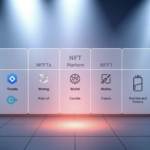Now Reading: Artificial Intelligence Blockchain Gaming Tokens Explained
- 01
Artificial Intelligence Blockchain Gaming Tokens Explained
Artificial Intelligence Blockchain Gaming Tokens Explained

This roundup explains how the convergence of machine learning and distributed ledgers creates verifiable ownership, programmable economies, and monetizable play. It shows why U.S. players and studios care: users seek sovereignty over in-game assets, and developers want tamper‑resistant economies with clear rules and automated payouts.
The guide sets expectations: a clear framework to evaluate gaming-focused coins, data-backed selections, and actionable takeaways for commercial research. We note market context — the sector jumped from a $4.6B valuation in 2022 and faces rapid growth — and stress that prices and caps move fast.
How this works: machine learning powers smarter matchmaking, dynamic NPCs, and on‑chain agents, while ledgers record transfers, enforce scarcity, and automate rewards via smart contracts. Token models support governance, staking, liquidity, and in‑game sinks to keep economies healthy over time.
Selection criteria include fundamentals, teams, partnerships, tokenomics, adoption signals, and regulatory awareness. We reference real projects like NEAR, TAO, and RENDER as examples and remind readers that all figures are point‑in‑time and should be cross‑checked.
Key Takeaways
- Clear framework to assess game-focused crypto assets and their utilities.
- Market expansion makes timely price and cap checks essential.
- AI-driven features boost gameplay; ledgers secure ownership and payouts.
- Token models must balance governance, staking, and utility sinks.
- Evaluation uses fundamentals, teams, partnerships, and tokenomics.
What AI-meets-blockchain means for gaming in the United States
In the United States, the mix of on‑chain asset models and adaptive game agents is reshaping how players earn, trade, and influence virtual worlds.
AI-driven agents, personalization, and procedural content can make play more engaging while crypto-led ownership enforces clear marketplace rules. Players get portable, tradable items and new play-to-earn paths.
For U.S. publishers this opens monetization opportunities: primary sales, automatic royalties on secondary sales, and programmable economies that cut down fraud and gray markets. Studios can launch with on‑chain settlement for assets while keeping latency-sensitive gameplay server‑side.
Compliance matters. KYC/AML at exchange onramps, tax reporting for in‑game earnings, and data minimization patterns help meet U.S. privacy and regulatory expectations.
- Infrastructure advances: low-fee L1/L2 networks, decentralized GPU rendering, and privacy-preserving compute let developers build richer titles.
- Interoperability: portable identity and items increase lifetime value and retention across platforms and web3 experiences.
- Security: transparent ledgers and on‑chain logs reduce duping; audits become table stakes for U.S. audiences.
Understanding crypto gaming tokens and their real utility
Standards-based digital assets enable clear ownership and cross-platform trade. Developers use ERC-20 for fungible currency and ERC-721/1155 for unique items. This makes it simple to move value between a game wallet and external marketplaces.
Ownership, governance, and in-game economies
Fungible coins power transactions, rewards, and shop purchases. NFTs represent unique characters, skins, or land with provable scarcity.
Governance often follows token-weighted voting for balance updates, emission schedules, and treasury spend. That aligns player incentives with studio roadmaps.
DeFi integrations: staking, liquidity, and rewards
Many titles embed staking programs and LP incentives to deepen liquidity. Bonding curves and in-game AMMs can stabilize marketplace pricing.
- Rewards link to quests and skill‑based play to avoid pure inflation.
- Meaningful sinks—repairs, crafting, tournament fees—remove supply.
- On-chain analytics track supply, velocity, and concentration for balance checks.
| Category | Primary Use | Example Mechanic |
|---|---|---|
| Fungible coin | Transactions & rewards | Staking for perks |
| NFT | Unique items & ownership | Royalty-enabled trades |
| DeFi pool | Liquidity & price stability | LP rewards & bonding curves |
Why invest now: growth signals and commercial opportunities
Rapid market expansion and capital inflows make this a clear moment to reassess positions. MarketsandMarkets values the space at $4.6B in 2022 and projects $65.7B by 2027 (70.3% CAGR), a sign of strong growth potential.
Play-to-earn models have evolved. Projects now favor skill-weighted rewards, seasonal systems, and creator-driven revenue that reduce pure emission risk and improve long-term adoption.
AI-driven content and agentic NPCs can boost retention and ARPU for live-service titles. That commercial upside creates B2B opportunities in middleware, decentralized compute, privacy tech, and DeFi rails studios can license.
- Valuation drivers: active users, transaction velocity, fee capture, IP deals, and cross-chain reach.
- Market access: exchange listings and liquidity shape price discovery and institutional readiness for U.S. buyers.
- Entry cues: mainnet launches, major partnerships, listings, and seasonal drops.
| Signal | Why it matters | Example |
|---|---|---|
| DAU growth | Drives fees and secondary market depth | Projects with rising daily wallets |
| Liquidity & listings | Reduces spreads and slippage | Exchange debut and higher volume |
| B2B licensing | Recurring revenue streams for platforms | Middleware and compute marketplaces |
How we selected the top tokens for this Product Roundup
Our shortlist reflects measurable fundamentals and repeatable signals, not hype cycles.
Selection began with project fundamentals. We checked roadmaps, whitepapers, and milestone delivery. Clear vision and robust architecture lower execution risk.
Team pedigree and partnerships mattered next. We verified developer track records, named alliances with major platforms, and security audits or bug bounties.
Tokenomics, utility, and adoption signals
We analyzed supply, vesting schedules, and emission pacing to spot fair allocations. Utility—fees, sinks, and staking—must drive real demand.
Security, privacy, and regulatory awareness
Audits, incident response plans, and governance safeguards are non‑negotiable. Privacy protections and U.S. regulatory mindfulness help projects scale without costly setbacks.
- Adoption: active users, marketplace volume, and developer traction.
- Liquidity: order book depth, multi‑exchange listings, and on‑chain pools.
- Documentation: transparent docs and clear disclosures improve holder confidence and knowledge.
| Factor | Why it matters | Signal |
|---|---|---|
| Fundamentals | Reduces execution risk | Delivered milestones |
| Market & liquidity | Supports trading | Listings & pools |
| Security & privacy | Protects users | Audits & controls |
Bottom line: our method favors durable value in the crypto and gaming market. This keeps the analysis practical for U.S. investors and developers evaluating the ecosystem.
Top artificial intelligence blockchain gaming tokens
Below are leading projects where compute, data and decentralized markets meet playable worlds.
Render (RENDER)
Use case: decentralized GPU marketplace for 3D rendering and model training.
Why it matters: studios rent burst power without big cloud bills. 2025 cap ~ $1.8B; supply ~533M.
NEAR Protocol (NEAR)
Use case: sharded finality and low-cost data storage for scalable backends.
Why it matters: Nightshade improves throughput for live services. 2025 cap ~ $3.15B.
Injective (INJ)
Use case: finance-grade rails for in-game markets with cross-chain trading and staking.
Bittensor (TAO)
Use case: open model marketplace that rewards ML contributors and inference providers.
Virtuals Protocol (VIRTUAL)
Use case: on-chain agents that interact, earn, and provide entertainment services.
Theta Network (THETA)
Use case: streaming-first media network and edge compute for low-latency play.
Oasis Network (ROSE)
Use case: privacy-preserving compute (TEEs) for secure player data processing.
Artificial Superintelligence Alliance (FET/ASI)
Use case: unified agent and compute marketplace under a single token economy.
Ocean Protocol (OCEAN)
Use case: compute-to-data for model training and monetized datasets.
| Project | 2025 Cap (approx) | Core utility |
|---|---|---|
| Render | $1.8B | Decentralized GPU rendering |
| NEAR | $3.15B | Scalable sharded protocol |
| Injective | $1.31B | Cross-chain markets & staking |
| Bittensor | $3.11B | Model marketplace |
| Virtuals | $749M | Agent-driven entertainment |
| Theta | $786M | Media streaming & edge compute |
| Oasis | $185M | Privacy compute |
| FET/ASI | $77M | Autonomous agent ecosystem |
| Ocean | $175M | Compute-to-data marketplace |
Actionable tip: compare live prices and caps before deciding. Match each project’s core utility to your strategy and risk profile in the U.S. market.
Market snapshot: prices, caps, and sector leaders to watch
Look at price, cap, and volume together to understand how a network performs in real time.
Market cap equals circulating supply multiplied by current price. Use it to gauge scale across crypto projects—NEAR (~$3.36B), TAO (~$2.95B) and RENDER (~$1.73B) sit at the top, while OCEAN (~$175M) and VIRTUAL (~$665.7M) are smaller.
Compare current price to an asset’s all‑time high to see downside and potential recovery. For example, NEAR trades ~87% below its ATH; RENDER sits ~75% below. This frames risk and reward.

What to watch
- 24H volume: a liquidity signal—NEAR ~$118M, INJ ~$53M—affects slippage and execution when trading larger positions.
- Dispersion: multi‑billion caps offer resilience; sub‑billion projects carry more swing risk.
- Catalysts: dev milestones, token unlocks, and partnerships often precede price moves.
| Metric | Why it matters | Example |
|---|---|---|
| Market cap | Scale vs peers | NEAR $3.36B |
| 24H volume | Liquidity | NEAR $118M |
| ATH gap | Downside context | RENDER -75% |
Bottom line: cross‑check listings, scan order books before trading, and balance top‑cap exposure for resilience with mid‑cap exposure for upside. Use fundamentals and adoption momentum alongside technicals for your final analysis.
Token utility in gaming ecosystems: where value accrues
Value in play systems often starts with small, repeatable actions that funnel in‑game spending into lasting demand.
Access and fee models create immediate utility. Access tokens unlock premium modes, creator tools, and early drops. Fee tokens power crafting, land fees, and cross‑platform tolls that make each interaction meaningful.
Governance rights also matter. When holders vote on emissions or treasury grants, future value gets priced into the market. That ties speculative upside to real decisions about roadmaps and grants.
Infrastructure layers add indirect demand. Compute credits, render credits, and compute‑to‑data payments monetize developer and player activity outside the core game loop.
- Marketplace royalties reward creators and stabilize item prices.
- Staking perks offer boosts, whitelists, and cosmetic access instead of pure yield.
- Interoperability increases item use across platforms and raises token velocity.
| Utility Type | How value accrues | Example |
|---|---|---|
| Access | Drives willingness to pay for premium content | Season pass tokens |
| Fee | Creates sinks and funds operations | Crafting & land management fees |
| Infrastructure | Captures developer demand for compute and data | Render credits / inference calls |
Tokenomics that sustain player and investor incentives over time
Healthy tokenomics start with clear supply rules and sinks that recycle value into play.
Predictable supply schedules and visible vesting reduce sudden sell pressure. That builds confidence for both players and market participants.
Emissions should align to engagement milestones and seasonal events, not a flat inflation rate. Reward creator contributions with staged releases tied to activity.
In-game sinks—crafting costs, repair fees, tournament entries, and cosmetic mints—remove supply and reinforce loops that keep value meaningful.
- Dual vs single currency: a currency + governance split can separate utility from voting, while a single design trades simplicity for broader financial use.
- Staking: lock-ups that grant access or boosts shift demand from yield farming to gameplay utility.
| Issue | Design | Player benefit | Market effect |
|---|---|---|---|
| Vesting | Transparent schedules | Predictable supply | Lower sell shocks |
| Sinks | Craft burns & fees | Meaningful spending | Controlled inflation |
| Treasury | Grants & buybacks | Supports builders | Liquidity & stability |

Telemetry-led balancing—tracking velocity, sink use, and holder cohorts—lets governance iterate responsibly. Sustainable systems put players first; that supports long-term market health and asset utility.
AI agents, interoperability, and cross-game asset mobility
Autonomous agents are changing how players interact with virtual worlds. They act as persistent actors that can quest, trade, moderate, or entertain and keep engagement steady between sessions.
Standard token formats and bridges let items and identity move across games. This portability extends item lifecycles and protects player investment in skin, gear, or status.
- Monetization: agents earn via inference fees, performance bounties, and creator splits that align incentives across the ecosystem.
- Cross-game features: quests, leaderboards, and reputation recorded on-chain power shared progression and visible prestige.
- Design controls: staking, rate limits, and reputational slashing prevent abuse and limit spam.
Developers benefit as agent frameworks reduce content load and spawn emergent experiences. L2 rollups and message-passing keep latency low while anchoring state on secure layers.
| Benefit | Impact |
|---|---|
| Interoperability | Higher retention across platforms |
| Monetization | New creator revenue streams in web3 |
| Governance & IP | Requires clear licensing and legal guardrails |
U.S. opportunity: lead in agent frameworks that respect user rights and unlock fresh entertainment formats across the crypto network and broader world.
Privacy, security, and trust in AI-powered game economies
Player trust starts with clear privacy and rigorous security. Private inference and careful data handling enable personalization without exposing raw user records. That protects players and eases regulatory concerns for U.S. platforms.

Privacy-preserving compute, like Trusted Execution Environments used by Oasis Network, lets studios run analytics and model inference while keeping player data confidential. Enterprise partnerships (for example, Theta’s deals with Sony and Google) also signal practical trust for creators and investors.
- Security fundamentals: audited smart contracts, least-privilege keys, multisig treasuries, and live monitoring reduce exploit risk.
- Governance controls: parameter changes, emission caps, and treasury moves should require community approval or multi-party signoff.
- Marketplace integrity: provable provenance, anti-duplication checks, and transparent logs ease disputes.
- User safety: wallet best practices, phishing education, and safe-approve patterns limit malicious contract interactions.
- Reputation systems: agent and creator ratings discourage fraud and reward consistent quality.
Transparency matters: independent audits, open-source code, and timely incident reports build long-term confidence in the crypto market and across the broader ecosystem. Privacy-by-design and security-by-default are competitive differentiators for studios launching on-chain applications in the U.S. market.
How to buy and store gaming-focused AI crypto
Prioritize exchanges that combine regulatory compliance and strong liquidity to protect your execution when you invest crypto in game-related assets.
Choosing exchanges and executing orders
Start with U.S.-friendly platforms like Coinbase or Kraken when possible. They list many coins and show real 24H volume, which matters for execution quality.
Use limit orders for mid-cap gaming assets to avoid wide spreads. Market orders work for high-liquidity coins but can slippage on lower-volume listings.
Monitor volume and volatility. Consider dollar-cost averaging in fast-moving markets to smooth entry price and reduce timing risk.
Wallet best practices: hardware vs. software vs. paper
Custody choices: hardware wallets keep private keys offline for long-term holdings. Software wallets make day-to-day trading and staking simple. Paper wallets—printed QR codes—are an offline backup option.
Follow wallet hygiene: store a unique seed securely, resist phishing, run small test transfers, and review contract addresses from official sources before moving significant funds.
- Enable multi-factor authentication and set withdrawal whitelists on exchanges.
- Use allowance reviews and simulate transactions for unfamiliar smart contracts.
- If bridging chains, confirm bridge reputation and fees before moving assets needed for play or staking.
| Step | Why it matters | Practical tip |
|---|---|---|
| Exchange choice | Liquidity & compliance | Prefer regulated U.S. platforms with listed coins |
| Order type | Control execution price | Use limit orders for mid-cap coins |
| Custody | Security vs convenience | Hardware for cold storage; software for active use |
Tracking and taxes: use analytics dashboards and explorers to reconcile transactions. U.S. filers should log realized gains and rewards when planning to invest crypto in this market.
Risk lens: volatility, hype cycles, and due diligence essentials
Smart due diligence separates promising projects from overpromised marketing and recycled code.
Core risks include steep price swings, liquidity dry-ups, smart‑contract exploits, governance capture, and misleading tech claims.
Verify sources before you act. Check public repositories, formal audits, testnets or mainnets, and working prototypes—not just press pages or tweets.

Red flags: guaranteed returns, opaque allocations, rapid token unlocks, fake partnerships, and minimal code novelty.
- Do a whitepaper and team background review.
- Scan community sentiment and on‑chain metrics.
- Confirm treasury transparency and audit history.
U.S. regulatory watchpoints matter. Token classification debates and exchange policies can limit access or change tax/treatment.
| Protection | Practical step |
|---|---|
| Cold storage | Keep long-term holdings offline |
| Limited permissions | Use allowance reviews and hardware wallets |
| Scenario planning | Predefine exit, hedging, and stop-loss rules |
Portfolio rules: size positions to cap downside, use stop-loss or time-based rebalancing, and avoid concentration in one sector.
Final note: gaining knowledge takes years; patience and disciplined analysis beat FOMO when you decide to invest crypto or explore market opportunities.
Analysis playbook: comparing gaming tokens for long-term potential
Begin by mapping hard signals—mainnet upgrades, partner integrations, and sustained on‑chain activity—to long-term prospects.
Scoring model: weight fundamentals, team, partnerships, tokenomics, adoption, security, and regulatory posture. Assign 0–10 for each pillar and total for a normalized rating. This creates a repeatable comparison across projects and protocols.
Community and partnerships
- Measure community vitality: active contributors, developer grants, event cadence, and discord/chain engagement.
- Verify partnership substance: shipped integrations, co-developed features, and measurable user flows rather than logo placements.
Technical & market checks
Track roadmap delivery: mainnet upgrades, sharding work, and agent framework releases. Compare cost-to-transact and throughput for playable mechanics—fees and latency matter for session-based play.
Evaluate demand drivers: sinks, access privileges, governance roles, and fee capture that anchor real token utility. Assess liquidity across exchanges and bridges to avoid fragmentation.
| Metric | Why it matters | Signal |
|---|---|---|
| Roadmap delivery | Predicts execution | Mainnet upgrades shipped |
| Community health | Drives retention | Active dev commits & grants |
| Liquidity & bridges | Enables trade & use | Multi‑exchange listings & stable bridges |
Sensitivity analysis: model impacts from unlock schedules, emission changes, or regulatory shifts on supply/demand. Stress-test treasury plans and grant pacing to see who bears short-term dilution.
Bottom line: use the rubric to score new entrants consistently. Repeat the analysis as milestones arrive to convert noisy data into clear, long-term signals for U.S. investors and builders.
Future outlook: the next wave of AI x gaming adoption
The next wave will fuse autonomous companions, decentralized rendering, and privacy-safe personalization into mainstream play.
Market projections point to sustained expansion through 2027, with a 70.3% CAGR that highlights serious growth potential for crypto projects tied to these pillars.
Expect agent-native titles where autonomous companions, rivals, and creators reshape how players engage and monetize time in-game. Studios will lean on decentralized render networks and edge media to deliver cinematic experiences on everyday devices.
- Privacy-first personalization will be standard, enabling safe analytics without exposing raw player data.
- Interoperability will rise as studios chase retention and cross-game revenue.
- Regulatory clarity should broaden U.S. onramps and listings, boosting adoption and market participation.
| Pillar | Impact | Likely beneficiaries |
|---|---|---|
| Agent ecosystems | New play loops & monetization | Virtuals |
| Decentralized compute | Cinematic, low-latency experiences | Render |
| Privacy-preserving analytics | Safe personalization & trust | Oasis |
Practical note: track protocol upgrades, enterprise partnerships, and killer app launches. For integration trends and cross-world item flows, see work on NFT integration with metaverse platforms.
Make your move: align tokens with your strategy and timeframe
Map goals to a time horizon before you invest crypto. Decide if you want short-term event plays or long-term accumulation tied to roadmaps and adoption.
Match utility to exposure: pick projects that align with compute, agents, privacy, or DeFi rails and note each token’s core utility and liquidity.
Diversify across subsectors to balance cyclical narratives. Size positions by conviction and set rebalancing intervals that fit volatility and your plan.
Use limit orders and staged entries to reduce execution risk in mid-cap names. Pair holdings with participation — staking, governance, or creator activity — when utility is meaningful.
Monitor treasury moves, emission schedules, partnerships, and user growth. Secure core coins in cold storage and keep hot wallets for active platforms. Select a shortlist, confirm live market data, and execute with clear risk controls as you build knowledge.















